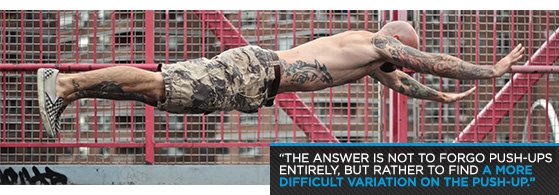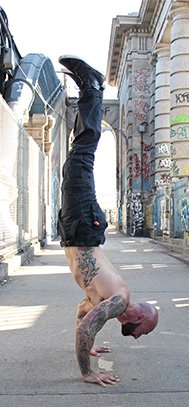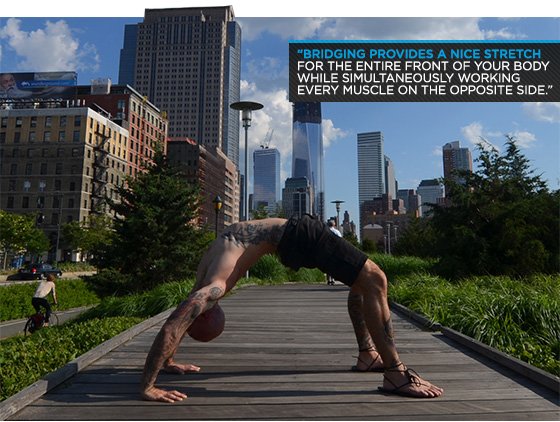Every day I hear from guys who've been banged up from lifting weights and are curious to try switching part or all of their program over to calisthenics-based resistance training. Though they recognize the benefits of bodyweight training—improved joint health, increased mobility, and greater proprioception—putting down the weights often comes with some hesitation.
For most people, it's hard to accept that anyone can get strong and muscular without ever moving an external object. It just seems too simple to be true. Besides, an entire industry wants you to believe otherwise so it can keep making money off all those contraptions.
You can train every muscle in your body to grow stronger without ever going to a gym, lifting weights, or using any high-tech machines. You just have to be creative and keep raising the stakes!
I know you're curious—especially if you've ever seen someone do a one-legged squat or one-armed push-up and wondered why you couldn't. The answer is simple: They made the choice and did the work. Here are some guidelines to successfully swap out standard weight training exercises for bodyweight equivalents without sacrificing your strength and muscle.

I know what you might be thinking: Push-ups are too easy to replace the bench press, right? Before you start in with how you can do push-ups all day and never get tired, hear me out.
Trainers know that to achieve strength and muscle gains, you need enough resistance to fatigue your muscles in around 5-15 reps, give or take a rep or two. If you can bust out 50 straight push-ups without breaking a sweat, however, the answer is not to forgo push-ups entirely, but rather to find a more difficult variation on the push-up.
Close-grip (aka "diamond") push-ups are a perfect progression from the standard shoulder-width variety, and when those get easy, you can start training toward clapping push-ups and one-arm push-ups.
What's that, still too easy for you? How about clapping one-arm push-ups?

The overhead press is one of the most fundamental strength training techniques out there, and for good reason. Overhead pressing is a great way to build upper-body strength as well as a strong core. The handstand push-up is basically the same movement pattern turned upside down. Get ready to flip this classic exercise on its head—literally!
Unlike standard push-ups, handstand push-ups require a great deal of strength. If you aren't ready for handstand push-ups yet, try doing them with your body bent in half at the hips and your feet resting on a bench. This is sometimes known as a pike press.
Even guys who prefer lifting weights over calisthenics usually acknowledge the pull-up as king of upper-body pulling movements. Everyone should do pull-ups, and if you can't do a pull-up, you can work toward one by practicing flex hangs and negatives.
For many people, simply working toward being able to do 10-15 pull-ups is enough of a challenge. However, just as with push-ups, if pull-ups ever get too easy for you there are a lot of ways to ramp up the difficulty. Just a few include clapping pull-ups, muscle-ups, one-hand pull-ups (where your opposite arm grips your forearm), and—you guessed it—one-armed pull-ups.
The Australian pull-up (or bodyweight row, or supine row, as it's also known) can be a great tool for a beginner to help work toward a full pull-up. However, even pull-up bar aficionados can still benefit from keeping this move in their regimen.
Try placing them in your workout after standard pull-ups when your back muscles are already fatigued. If they're still not challenging enough for you, mix it up by elevating your feet or adding a plyometric component. Trust me, they're harder than they look!
All About Australian Pullups
Watch the video: 01:19
This one's a no-brainer. By squatting on just one leg, you automatically double the amount of resistance on your squat without needing any external load. Hell, even guys who can comfortably squat more than their bodyweight on a barbell still struggle with one-legged pistol squats. The pistol will challenge your balance and mobility, as well as potentially eradicating minor lower-body muscle imbalances. They take plenty of practice, so don't be discouraged if you can't do them right away.
If you're not strong enough for a pistol yet, there are simpler single-leg squat variants that you can use to gradually progress. You'll never have to worry about that guy doing curls in the squat rack ruining your leg day again. In fact, you won't even need the gym at all.
OK, you've got me here. There's really no way to do a deadlift without doing a deadlift. However, there are effective ways to work the same muscles with just your bodyweight.
The back bridge is one such exercise. Bridging provides a nice stretch for the entire front of your body while simultaneously working every muscle on the opposite side. It's a fantastic strengthener for the entire posterior chain. You can do them for reps or simply hold the top position for time.

The back lever is definitely an advanced move, but if you're ready for it, it's also a fantastic tool for working your lower back, glutes and hamstrings. And just like good ol' deadlifts, back levers will also give your grip a nice workout.
I love picking a heavy-ass bar off the floor as much as the next guy, but these two exercises can give you bullet-proof hamstrings and lumbar made of lumber.
If you love weight training, I'm not telling you to give it up. In fact, a hybrid program that combines bodyweight exercises and weight training works even better for some people than calisthenics alone. If you simply can't imagine dropping squats or deads, you could simply spend a month dedicating your chest or shoulder workouts to bodyweight work—or vice versa. You've got to do what's appropriate for your body and your goals.
Having said that, I bet most people reading this article would find a few weeks of straight-up bodyweight calisthenics to be a refreshing and surprisingly challenging endeavor, if they selected appropriately difficult movements and practiced them with dedication.
Try it for a month. You might not even miss the iron at all.
